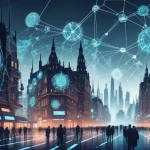Hyundai’s AI Revolution in U.S. Shipbuilding: Blockchain Potential Explored

Hyundai’s AI Push to Revamp U.S. Shipbuilding: A Tech Disruption Play with Blockchain Potential
Hyundai Heavy Industries is throwing a technological haymaker at the dilapidated U.S. shipbuilding sector, wielding artificial intelligence (AI) to slash delivery times and drag rusted shipyards into the digital age. Backed by a jaw-dropping $150 billion commitment from South Korea, this initiative promises to fuse Seoul’s manufacturing muscle with American computing power. But as advocates of disruption and decentralization, we’re asking: can AI, paired with blockchain’s trustless systems, truly overhaul an industry on life support, or is this just another shiny tech promise destined to rust?
- AI Overhaul: Hyundai aims to modernize U.S. shipyards with AI, slashing delays and building smarter operations.
- Big Money, Big Strategy: South Korea’s $150 billion investment doubles as a geopolitical chess move against China.
- Blockchain Synergy: Decentralized tech could amplify AI with transparent supply chains and automated contracts.
- Harsh Realities: Labor shortages and crumbling logistics might blunt even the sharpest tech solutions.
Hyundai’s AI Gamble: A Blueprint for Smart Shipyards
The U.S. shipbuilding industry has been a sinking ship for decades, bogged down by inefficiencies, outdated infrastructure, and delivery delays that stretch into double-digit years. Hyundai Heavy Industries, a heavyweight in South Korea’s globally dominant shipbuilding scene, is stepping in with a radical plan to turn the tide. By merging their production expertise with the U.S.’s edge in digital platforms, they aim to transform creaking shipyards into smart, AI-driven hubs. Think automated systems predicting machine failures before they happen, or real-time design tweaks saving millions in construction costs. Aerin Jungmin Lee, AI Strategy Lead at Hyundai, lays out the vision with precision:
“We have production expertise, and the US has advantages in digital platforms. If we can leverage the US’s exceptional computing resources, it would significantly speed up research, including model development and processing, and ultimately serve as a foundation for building smart shipyards.”
Hyundai isn’t just talking theory. They’ve already rolled out an AI translation system connecting 12,000 workers across 17 countries in three shipyards, enabling seamless communication despite language barriers. Imagine a Korean engineer and an American welder troubleshooting in real-time without missing a beat—that’s the kind of efficiency we’re talking about, as detailed in their ambitious push to fast-track American ship orders with AI. Later this year, they plan to unleash the “Shipbuilding AI Master Agent,” a tool designed for real-time diagnostics, design optimization, and data analysis. This isn’t a gimmick; it’s about catching flaws in a ship’s blueprint before steel is cut, or preserving decades of institutional know-how as skilled workers retire. Partnerships with U.S. tech giants like Google, Palantir, and Anduril provide the digital firepower, from raw computing muscle to defense-grade AI systems. But let’s not get too starry-eyed—tech this ambitious often comes with bugs, both literal and figurative.
Geopolitical Chessboard: South Korea’s Strategic Play
Beyond the nuts and bolts, there’s a bigger game at play. South Korea’s $150 billion pledge to revive U.S. shipbuilding isn’t just about economics; it’s a calculated move to boost Seoul’s global industrial clout and reshape perceptions of its standing against China. Tied to trade agreements with Donald Trump’s administration, this investment signals a tightening U.S.-South Korea alliance amid rising geopolitical tensions. Aerin Jungmin Lee doubles down on AI’s broader potential, framing it as a lifeline for structural challenges:
“I believe AI will accelerate global industry restructuring. It can be the most realistic solution to the structural limitations that not just us, but Korea faces as a whole, while helping us respond to competition against China or mitigate external uncertainty including tariffs.”
This isn’t just about building ships faster—it’s about building influence. South Korea sees an opportunity to position itself as an indispensable tech and industrial partner to the U.S., especially as trade wars and tariffs loom large. Yet, geopolitics is a double-edged sword. A sudden U.S.-China trade spat or policy flip could derail this partnership faster than a shipyard strike. Tech might be the tool, but human politics remain the wildcard.
U.S. Policy Push: Genesis Mission and the AI Wave
On the American side, there’s a parallel push to embed AI into the national fabric. Trump’s recent executive order establishing the Genesis Mission aims to integrate AI into federal research, targeting breakthroughs in materials engineering (think stronger, cheaper alloys for ships), health science, and energy innovation. Backed by supercomputing resources from Nvidia, Dell, HPE, and AMD at Department of Energy national labs, this initiative signals a broader recognition of AI as a catalyst for industrial revival. Michael Kratsios, Head of the White House Office of Science and Technology Policy, captures the stakes with unbridled optimism:
“With the power of AI, America is on the brink of a scientific revolution.”
This mirrors the early days of blockchain research, when governments and institutions began eyeing decentralized systems as tools for disruption. Much like Bitcoin challenged centralized finance, AI is poised to upend centralized inefficiencies in manufacturing and research. But here’s the rub: government programs often promise the moon and deliver a pebble. If Genesis Mission gets bogged down in red tape or mismanagement, it could fizzle out as just another political talking point. Still, the alignment of private tech giants with public goals hints at a momentum that’s hard to ignore.
Challenges: Labor Gaps and Logistical Nightmares
Before we start hailing Hyundai as the savior of American shipbuilding, let’s face the ugly truth. The challenges are as towering as a supertanker. Financial analysts at Nomura have raised red flags about labor shortages, spiraling costs, and weak supply chains for Korean builders redirecting resources to the U.S. market. U.S. Navy ships often face delays of 5 to 10 years, compared to South Korea’s 2 to 3 years per vessel—a gap that no algorithm can weld shut overnight. AI might optimize designs or predict breakdowns, but it can’t replace a seasoned welder’s grit or sweet-talk a union into overtime. Hyundai’s got its work cut out, and no amount of tech can fully bypass the human element.
Supply chain woes are another beast. The U.S. struggles to source parts and materials at the pace needed for a revamped industry. Throw in rising costs and you’ve got a perfect storm that could sink even the smartest shipyard. Hyundai bets AI can mitigate these issues by acting as a force multiplier—streamlining what workers they do have and preserving knowledge as veterans retire. But let’s not kid ourselves: over-reliance on tech can backfire. What if algorithms miss cultural nuances in labor management, or a cyberattack cripples these shiny new systems? We’ve seen tech promises flop before—just ask any altcoin shiller from the 2017 ICO craze. Hype is cheap; results are hard.
Decentralized Tech: The Blockchain Connection
As champions of decentralization, we can’t help but see parallels between Hyundai’s AI push and the ethos driving Bitcoin and blockchain innovation. Both technologies aim to dismantle outdated, centralized systems—whether it’s financial intermediaries or rusty shipyard bureaucracies. So, how could blockchain amplify Hyundai’s vision? Let’s break it down.
For starters, blockchain could revolutionize supply chain transparency in shipbuilding. Picture a tamper-proof ledger tracking every component—from steel plates to navigation tech—from factory to port. No more shady middlemen or lost shipments; every stakeholder, from Hyundai to U.S. suppliers, sees the same unalterable data. Ethereum-based smart contracts could take it further, automating payments between parties as milestones are met. Imagine a contract that releases funds to a supplier the moment a shipment is verified via IoT sensors—no delays, no disputes, just efficiency.
Tokenization offers another angle. What if ship components or even entire vessels were crowdfunded via tokenized assets on a blockchain? Investors—perhaps even Bitcoin holders looking to diversify—could buy into fractional ownership of a ship’s construction, democratizing funding much like DeFi disrupted traditional banking. This isn’t sci-fi; blockchain’s already being piloted in logistics and trade finance. Pair it with Hyundai’s AI, and you’ve got a disruptive stack that could redefine global manufacturing. Sure, regulatory hurdles and adoption barriers loom large, but the potential is as tantalizing as Bitcoin’s first bull run.
Even more intriguing is how blockchain aligns with AI to tackle labor and knowledge gaps. Decentralized platforms could store and share institutional know-how across borders, ensuring a retiring welder’s expertise isn’t lost but accessible via secure, permissioned networks. It’s not a perfect fit—blockchain’s scalability issues and energy costs are real—but the synergy with AI’s predictive power could be a game-changer. If Hyundai’s serious about disruption, they’d be wise to explore this intersection. We’re watching, and we’re not holding our breath for half-baked promises.
What’s Next for Tech Disruption?
Hyundai’s gamble on AI to fast-track American ship orders is a bold test of tech-driven disruption, echoing the same rebellious spirit that fuels the crypto revolution. The road ahead is a minefield—labor shortages, logistical quagmires, and geopolitical curveballs could tank even the best-laid plans. Yet, the potential payoff, especially if blockchain enters the fray, could redefine not just shipbuilding but how we approach industrial inefficiencies across the board. South Korea’s $150 billion bet and the U.S.’s Genesis Mission signal a seismic shift toward embracing cutting-edge tools, but only results will prove if this is a brilliant stroke or a billion-dollar misstep.
As we cheer for disruption, a lingering question hangs in the air: if AI can rebuild ships, could blockchain rebuild trust in global trade? The intersection of these technologies might just be the next frontier for decentralization, much like Bitcoin upended money itself. We’re keeping a sharp eye on this space, ready to cut through any overhyped noise with the same skepticism we apply to moonboy price predictions. Tech promises are a dime a dozen—let’s see if Hyundai delivers the goods.
Key Takeaways and Questions to Ponder
- How is Hyundai using AI to transform U.S. shipbuilding?
Hyundai is integrating AI to blend South Korean manufacturing expertise with U.S. digital platforms, aiming to cut delivery times with tools like real-time translation for 12,000 workers and a forthcoming AI Master Agent for diagnostics and design optimization. - What’s behind South Korea’s $150 billion investment in this sector?
It’s a strategic push to elevate Seoul’s global industrial role and counter China’s influence, tied to trade deals with the U.S. under Trump’s administration. - Can AI overcome deep-rooted challenges like labor shortages?
AI can streamline processes and preserve knowledge, but it can’t fully replace skilled workers or fix broken supply chains—human and logistical issues remain massive hurdles. - How could blockchain enhance Hyundai’s AI-driven shipbuilding efforts?
Blockchain offers supply chain transparency with tamper-proof ledgers, smart contracts for automated payments on platforms like Ethereum, and even tokenized assets to crowdfund ship construction, aligning with decentralization principles. - What does the Genesis Mission indicate about U.S. tech policy?
Trump’s executive order reflects a national drive to embed AI in research and industry, much like early blockchain exploration, signaling a future where disruptive tech shapes policy and production.



